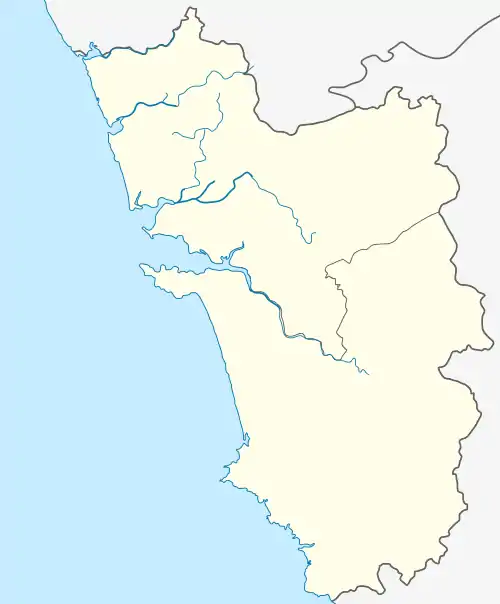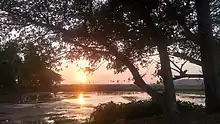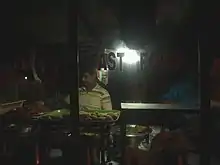Santa Cruz, Goa
Santa Cruz or Calaphur is a village-suburb of the Goan state capital of Panjim (Panaji).
Santa Cruz | |
|---|---|
Town | |
 Santa Cruz Location of Santa Cruz in Goa  Santa Cruz Santa Cruz (India) | |
| Coordinates: 15°28′15″N 73°50′35″E | |
| Country | India |
| State | Goa |
| District | North Goa |
| Sub-district | Ilhas de Goa |
| Population (2011) | |
| • Total | 21,000 |
| Time zone | UTC+5:30 (IST) |
| PIN | 403005 |
| Area code(s) | 0832 |
Largest, population

Santa Cruz (meaning holy cross in Portuguese) is the largest village in Goa with a population of 21,000 people different religions and also who trace their origins to different parts of India.
Location
Geographically, it is situated in the North Goa district in the Sub-District of Ilhas de Goa (which means Islands of Goa, in the Portuguese language) or Tiswadi (thirty villages in Konkani) taluka or sub-district.
Santa Cruz is bounded north with Rio de Ourem (river of gold estuary, in Portuguese). Its neighbouring villages are Merces ("à mercê de" translates to "at the mercy of") village which stretches from the north-east to the east (on the east side of the NH 17), Bambolim which stretches from east to the south and Taleigao which stretches from the south to the west. Panjim, the capital city of the state of Goa located on the largest of the islands, is to its northwest.
Village geography

This village is sub-divided into 11 wards, each of which has its own individuality within the village. These include Bandh Vaddo (or Bandhar) (southwest of Santa Cruz Church at the foot of Taleigao hillocks), Bondir (around northeast of the Santa Cruz church, near the Rio de Oureum estuary to its southeast), Cabesa Ward (around south of Santa Cruz church at the foot of Bambolim hillocks), Primeiro Bairro (around Santa Cruz church at sea level), Segundo Bairro (north of Santa Cruz Church at sea level).
St. Cruz (Goa Assembly constituency) is also the name of a constituency of the Goa Legislative Assembly and is currently represented by Congress politician Antonio Fernandes (politician) of the Indian National Congress party. It was formerly represented by Atanasio Monserrate also known as "Babush" Monserrate,[1] and Victoria Fernandes. At one stage, this was the electoral constituency of the prominent Goan politician Dr. Jack de Sequeira.
Following is a list of the politicians who represented the constituency:
| Year | Legislator | Party |
|---|---|---|
| 1963 | Jack de Sequeira | United Goans Party |
| 1967 | Jack de Sequeira | United Goans Party |
| 1972 | Jack de Sequeira | United Goans Party |
| 1977 | Erasmo de Sequeira | Janata Party |
| 1980 | Michael Fernandes | Indian National Congress (Urs) |
| 1984 | Francisco Branco | Independent |
| 1989 | Victor Gonsalves | Indian National Congress |
| 1994 | Victoria Fernandes | Independent |
| 1999 | Victoria Fernandes | Indian National Congress |
| 2002 | Victoria Fernandes | Indian National Congress |
| 2007 | Victoria Fernandes | Indian National Congress |
| 2012 | Atanasio Monserrate | Indian National Congress |
| 2017 | Antonio Fernandes | Indian National Congress |
Places of interest
Santa Cruz has several places of interest. Among these are, Almacho Khuris (Souls Cross), Char Khambe (Four Pillars), Saint Anthony's Chapel, and its disappearing salt pans (mithagar or mithache agor) which form a part of the reclaimed waterlogged khazan (muddy fields with sludge [2]) lands that are also used for aquaculture, pisciculture and agriculture.
Almacho Khuris
Santa Cruz shares a border, in the northwest, with Taleigao village, and has an unusual story of how a boundary dispute was settled. The Taleigaokars (villagers of Taleigao accusing the Calaporkars, their counterparts in Santa Cruz, of encroaching into their territory where there valuable rice paddy fields. To this, the communities agreed to consult an oracle to settle the boundary dispute.
The night before the oracle was to be consulted, the Calaporkas dug a hole on the border and lowered a wooden coffin containing one of their men, "the patriotic Calaporkar", who could breathe through a tube, and then covered the hole.
So on the next day, when the time of decision arrived, both village leaders implored the oracle to answer their prayer. A long silence prevailed. The villagers comunidade leaders kept repeating in turns "To whom does this land belong?" And from the depths of the earth a faint voice replied: “Calapor! Calapor! Calapor!” to the smartly executed plan of pseudo joy and pseudo exultation of the Calaporkars who pretended to be very surprised. The deceived Taleigaokars accepted the oracle verdict and went home west—surprised, sad and frustrated.
The Calaporkars also had to go home and had to return to dig “the patriotic Calaporkar.” Everyone in Calapor made merry the whole night with caju feni—and the few who had secretly plotted this activity totally forgot the proud patriotic villager inside the coffin as they were drunk with caju feni. The Calapor villagers returned on the third day to the disputed territorial location to dig up the coffin, only to observe that the poor man had already died. In the coffin, they found mostly worms crawling. As a symbol of self punishment, to find a smart solution for a smart boundary disputed settlement they decided to remember the deceased human who was the patriotic Calaporkar. Hence, each villager took the worms and tied a worm on right side of his hip string which held his tambdi (red) kasti/cashti (loin cloth) in place (this coined the phrase "Bhenddak [3] Kiddo” or “waist worm”). Goa is a land of tambdi mathi (red mud/soil) and tambdi kasti (red loin cloth in the bygone days). On the very location, tradition says, stands the “Almacho Khuris” (Soul's Cross) which faces the Santa Cruz Church, Ilhas, Goa. The concrete Almacho Khuris monument about 10’ tall commemorates the boundary disputes triumph and tragedy after Christianity replaced traditional symbols. Hence, every Calaporkar villager is referred to as “Bhenddak Kiddo.”[4] The Almacho Khuris is a historic border dispute monument which lies on a bandh between villages of Santa Cruz and Taleigao.
Char Khambe
The Four Pillars or the 'Char Khambe', as they are called in the Konkani language, are painted white,[5] and are located in the khazan lands on the old Santa Cruz–Panjim roads in the marshy area of the Rio de Ourem (Portuguese for 'River of Gold'). This road is now named as Vasantrao Dempo Marg. During Portuguese rule, freedom fighters gathered here and held meetings and discussions, making it a very important landmark in Goa. It was built in 1896.[5][6]
The khazans—which refer to low-lying land situated near creeks or river side which is normally below high tide level—is situated on the St Cruz stretch. The area is surrounded by rice paddy fields on both the sides (north and south). It is one of the busiest roads in Panjim. With the hustle bustle all day long, the four pillars about 15' tall each, two on each side of the road may appear to be just another structure. Physically, the site act as a buffer between the hectic urban environment of city of Panjim and the serene village environs of Santa Cruz. The place, is part of the unique Goan landscape, is very fragile and irreplaceable in nature and any thoughtless human intervention can cause drastic and irreparable consequential damage in the long run. The site is a low-lying tidal flood plain and is part of the natural drainage pattern during the rainy season on account of the surrounding topography.
The marshy wetland is a host to mangrove vegetation which plays a definite role in the maintenance of vital ecological balance. The place is also a popular habitat to a wide variety of local and migratory birds and is a bird-watcher's delight. It is quite common to find researchers and bird lovers from distant countries here, with their trained cameras. This place finds mention on the Internet along with the Karmali lake, Chorao, Mayem lake and others in Goa.[7] But for the locals here, they aren't just structures. There are sluice gates at this structure, which controlled the flow of marine water for the salt pans, which are on the south. The north area is an estuary with plenty of flora and fauna. This area is believed by some locals to be haunted, with the haunting at its peak on full moon nights. According to the commuters who have travelled via the stretch, there is an eerie feeling that prevails at the spot. They have also claimed to have sighted some apparitions in the nights. Locals say that the area is jinxed and cursed and this is one reason for the numerous accidents taking place here. Others sightings reportedly include those of a lady dressed in a white saree and supposedly asking for a lift. People also claim of hearing cries and have even had a sudden breaking down of bikes as soon as they reach the Char Khambe.[8]

A unique organizational structure called comunidade, headed by a hereditary descendant, is involved in governing villages and regulating the agricultural activities in Goan villages. Each village constitutes a comunidade and has its own rules depending on the local customs. This is one of the oldest administrative setup, which is in existence for the past thousand years and has been recognised by the Constitution. In the past, the comunidade was responsible for reclaiming the waterlogged lands (khazans) along the coasts and making them suitable for agricultural activities, aquaculture, pisciculture and salt production.[9]
Religious institutions
In post-colonial days, people all from different religions and also from different parts of India have inhabited and called Santa Cruz their home. It is amazing how people of different religions do give importance to each other's festivals and exchange greetings.
Church of Santa Cruz,

The Igreja de Santa Cruz (Igreja means church in Portuguese, and Santa Cruz is the Holy Cross) is one of the several churches in Ilhas de Goa which was built in 1547.[10] It is also the only church in the town, serving one of the largest parishes in Goa. The Santa Cruz parish celebrates the parish feast of the Holy Cross which falls on the Sunday between 2 and 8 May every year and the feast of Our Lady of Rosary which takes place on the fourth Sunday of every January. Both these feasts are preceded by a novena, special church services run for a period of nine days in the church. Other important festive occasion are the yearly paddy harvest festival which is held on 24 August every year, a popular festival full of pomp where a church priest blesses the new crop produced.
Temples
The Hindus have their spiritual festival such as, Ganesh Chaturthi, Hindu Diwalli (festival of lights) and Shigmo. Lord Ganesh is widely worshipped as the God of education, knowledge, wisdom, wealth and destroyer of evils and obstacles.
Notable people
- Shri Visnum Giri S. Dempo (Goa's Land Baron) 16th Century Sociedade Familia do Dempo
- Padmashri Vasantrao S. Dempo (Industrialist) – The umbrella company is known as V.S. Dempo & Co.
- Mr. Luis Saturnino Cota[11] Goa's topmost family of musicians the Cota family
 Santa Cruz Crib 2007
Santa Cruz Crib 2007 Santa Cruz Church, Goa
Santa Cruz Church, Goa Modern House in Santa Cruz
Modern House in Santa Cruz
References
- "Goa MLA Monserrate wins in Defence minister Manohar Parrikar's backyard". timesofindia.indiatimes.com. Retrieved 16 May 2016.
- http://www.nizgoenkar.org/newsDetails.php?id=11560
- http://gogoa.net/useful_words_and_phrases.htm
- Super User. "Santa Cruz – GOACOM – GOA – INDIA – INFORMATION AND SERVICES IN GOA. Goa News, Goa Konkani News, Goa Sunaparant News, Goan Konakani News, Goa Video News, Goa Yellow Pages". goacom.com.
- Vishal P.G. "My Goa". mygoa123.blogspot.com.
- Das, Anuradha (7 October 2018). "panaji: Four silent sentinels of St Cruz | Goa News - Times of India". The Times of India. Retrieved 6 October 2019.
- De Souza, Savio. "THE COMUNIDADES OF GOA". Retrieved 1 January 2015.
- "When work equals fun..." amey6606.blogspot.com.
- Mani, K; Salgaonkar, BB; Das, D; Bragança, JM (2012). "Community solar salt production in Goa, India". Aquat Biosyst. 8: 30. doi:10.1186/2046-9063-8-30. PMC 3543363. PMID 23198813.
- "Parishes – Archdiocese of Goa and Daman". archgoadaman.org.
- "Luis Saturnino Cota". tiatracademygoa.com.